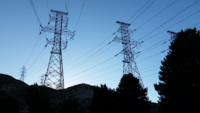
Photo from wikipedia
Abstract To guide the adjustment of the electricity policies of the 13th Five-year Plan and the present market-oriented reforms, this paper performs a scenario analysis of the CO 2 emissions… Click to show full abstract
Abstract To guide the adjustment of the electricity policies of the 13th Five-year Plan and the present market-oriented reforms, this paper performs a scenario analysis of the CO 2 emissions from China's electric power industry. By using a logarithmic linear equation to explain the relationship between CO 2 emissions and their influence factors, a hybrid model to forecast the “natural” development of the explanatory variables, and emission-relative data from 2001 to 2013 to estimate the equation parameters, five scenarios are designed, and the CO 2 emissions of each scenario are forecasted for the period of 2016–2030. On the basis of the modeling results, the sensitivity and contribution of each variable are also measured. Empirical analysis draws the following conclusions. (1) The electric power industry of China cannot easily reach its CO 2 emission peak before 2030. This will impose considerable pressure on the Chinese government to realize its emission mitigation target. (2) Compared with the non-fossil energy share in electricity generation, the CO 2 emissions from China's electric power industry are more sensitive to the changes in total electricity consumption and thermal power generation efficiency. (3) The increase in total electricity consumption is the single most important contributor to CO 2 emission growth from the electric power industry of China. (4) To mitigate future CO 2 emissions from the electric power industry, the Chinese government should optimize the industrial export structure and enhance its awareness of the increase in household electricity consumption.
Journal Title: Journal of Cleaner Production
Year Published: 2017
Link to full text (if available)
Share on Social Media: Sign Up to like & get
recommendations!